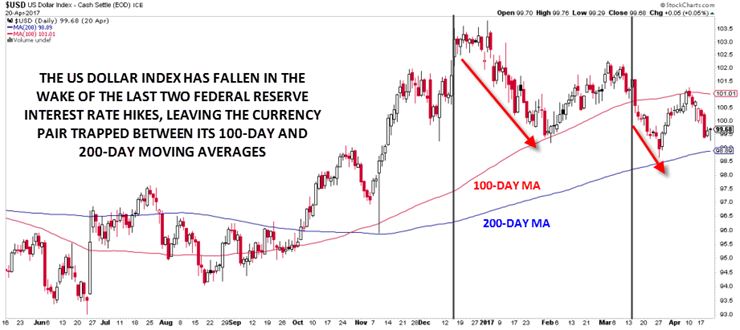It's been a strange last four months for the US dollar.
After the big post-election, "Trumpflation" surge, the greenback has seen the Federal Reserve raise interest rates twice...surely that would further support the world's reserve currency? As it turns out, the answer is an emphatic "NO!"
As a matter of fact, the two Fed rate hikes (December 14th and March 15th) have actually marked near term highs for the US dollar index, as the chart below shows:

Source: Stockcharts.com
This seemingly counterintuitive outcome is the result of traders' "second level" thinking. In both cases, everyone "knew" what the Federal Reserve was going to do in advance, and therefore the confirmation of the widely-expected rate hike was not a market-moving event. The dollar's reaction was instead a function of the central bank's tone and outlook for future interest rate increases (this led to the so-called "dovish hike" scenario last month). The fading hopes of an imminent infrastructure bill or comprehensive tax reform in the US no doubt exacerbated the drop.
Ironically, the falling expectations for the Federal Reserve could eventually provide a bullish catalyst for the dollar. Fed Funds futures traders are now pricing in "only" about a coin flip's odds (51%) of a rate hike at the Fed's June meeting. If we see a run of better than expected data and/or hawkish rhetoric from Fed officials, there's plenty of room for those expectations to get revised higher (unlike in December and March), and by extension, room for the greenback to rally. Of course, the converse is also true if we see weaker data or timid comments from Fed officials.
Looking ahead, the dollar index is at a critical crossroads. The currency hasn't dropped below its 200-day moving average at 99.00 since early October of last year, and if DXY slices through that floor, the dollar could see more pain in the coming weeks. On the other hand, a recovery to regain the 100-day MA near 101.00 would suggest that the dollar has found a near-term floor and could open the door for a retest of the highs above 103.00.
